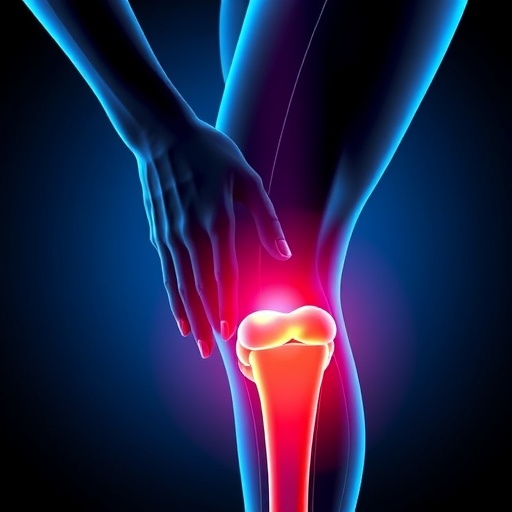Researchers from the University of Utah, New York University, and Stanford University have uncovered a promising innovation in the management of knee osteoarthritis, a condition affecting nearly a quarter of adults over 40. This painful degenerative joint disorder, characterized by the degradation of joint-cushioning cartilage, is a leading contributor to disability. Conventionally, treatment options have been limited to pain management through medication or eventual joint replacement surgery. However, this new study leads the way toward an innovative alternative: gait retraining.
The study, published in The Lancet Rheumatology, presents compelling data from a year-long randomized controlled trial demonstrating the effectiveness of a personalized gait modification program. Participants who learned to make slight alterations to their foot positioning while walking experienced significant pain relief, comparable to the effects of medication. Furthermore, they showed reduced degradation of knee cartilage over a year compared to those in a placebo treatment group, suggesting that this approach could mitigate the progression of osteoarthritis.
Previous understanding has long posited that individuals with osteoarthritis experience accelerated joint damage due to increased load on their knees. Researchers, led by Scott Uhlrich from the University of Utah, emphasized that an adjustment in foot angle can notably decrease this load. Despite this foundational knowledge, randomized, placebo-controlled investigations validating the effectiveness of such biomechanical interventions were sorely lacking until now, making this study a significant breakthrough in the field.
Focusing on patients with mild-to-moderate osteoarthritis affecting the medial compartment of the knee, wherein the internal part bears more weight than the outer compartment, the research honed in on a common yet nuanced aspect of skeletal health. Each individual’s optimal foot angle varies, influenced by their natural gait and how it shifts with a new walking style. This variability highlights the significance of personalized interventions—something that previous trials neglected and thus may have contributed to inconsistent outcomes.
The personalized nature of the study’s interventions is noteworthy. During initial visits, participants underwent a baseline MRI and were assessed while walking on a force-sensitive treadmill, enabling researchers to capture detailed mechanics of their gait. This meticulous analysis allowed for the archiving of data to determine which foot angle—whether a slight inward or outward turn—was most effective at alleviating knee pressure.
Furthermore, this personalized approach also allowed for the exclusion of individuals unlikely to benefit from the intervention, thereby refining participant selection. Previous studies included a wider range of participants, many of whom experienced no benefit from the uniform treatment applied. By focusing on tailored interventions, the research team aimed for improved compliance among participants regarding their revised gait patterns—a strategy that proved successful.
The study was structured so that participants were divided into two groups: one receiving the personalized gait intervention and another receiving sham treatment, with both groups practicing walking under supervision. The sham group practiced with foot angles that mirrored their natural stride, allowing researchers to measure the placebo effect accurately. Participants in the intervention group, meanwhile, practiced new foot angles established to minimize knee load effectively.
Sessions included six weeks of training, where participants benefited from biofeedback in the form of vibrations from a wearable device installed on their shins. This feedback mechanism reinforced the importance of adherence to the instructed foot angle. As participants continued their practice beyond initial training, check-in visits showed that most could maintain their prescribed angles with remarkable precision.
After a year, participants provided feedback on their knee pain and underwent follow-up MRIs to assess changes in cartilage health. The study revealed that the group that received personalized gait retraining experienced a notable reduction in pain—surpassing expectations derived from over-the-counter medications like ibuprofen and approaching levels typically associated with stronger narcotics.
The prints of success, however, extend beyond the numbers. Participants commented enthusiastically on the findings. The adjustments became integrated into their daily lives, allowing them to manage their osteoarthritis without relying solely on medication or mechanical aids. This perspective on personal agency over one’s health made the approach even more attractive.
For individuals in their 30s, 40s, or 50s, the potential for managing osteoarthritis through gait retraining could have far-reaching implications. The conventional narrative surrounding the condition often paints a bleak picture of impending pain management battles and inevitable joint surgery. However, interventions such as this one could serve as bridges during prolonged treatment periods, potentially delaying the need for invasive procedures.
Despite its promise, the study acknowledges the necessity of streamlining the gait retraining process for clinical application. The elaborate motion capture required for creating personalized training regimens presents logistical hurdles due to cost and complexity. The researchers envision a future where mobile technology, including video analysis via smartphones and smart footwear, can facilitate this intervention more seamlessly in physical therapy settings.
Before this innovative gait retraining can be broadly integrated into treatment protocols for osteoarthritis, further studies will be necessary to refine the approach and explore its accessibility. As research evolves, the prospect of individualized treatment delivered through modern technology has the potential to transform osteoarthritis management, emphasizing the importance of biomechanics in this chronic condition.
With a growing incidence of osteoarthritis as populations age, findings from this research may provide a much-needed alternative to current treatment paradigms. Innovations that widen the scope of effective therapies can enrich countless lives affected by this means, turning the tide against debilitating joint conditions.
As the scientific community gears up for the subsequent phase of research, interested participants are encouraged to engage with Uhlrich’s Movement Bioengineering Lab, as continual involvement in trials will be paramount to advancing this groundbreaking approach to osteoarthritis management. The journey toward making gait retraining a mainstream treatment option represents hope for countless individuals navigating the challenges posed by knee pain and cartilage degradation.
Subject of Research: People
Article Title: Personalised gait retraining for medial compartment knee osteoarthritis: a randomised controlled trial
News Publication Date: 12-Aug-2025
Web References: The Lancet Rheumatology
References: 10.1016/S2665-9913(25)00151-1
Image Credits: Utah Movement Bioengineering Lab
Keywords: Osteoarthritis, Mechanical engineering, Pain




